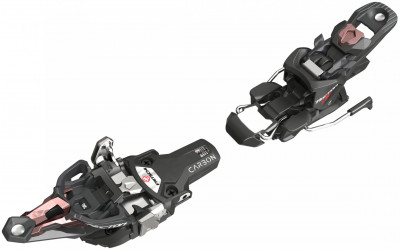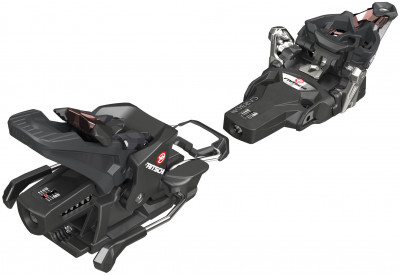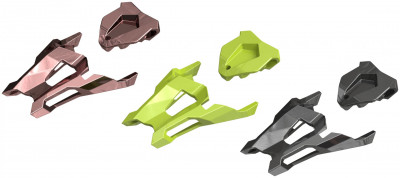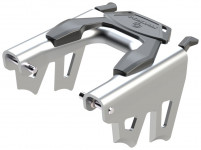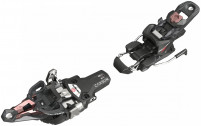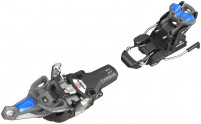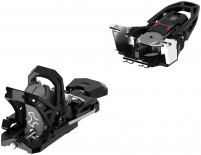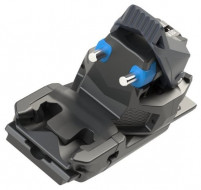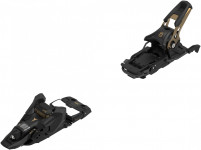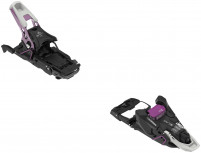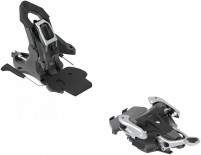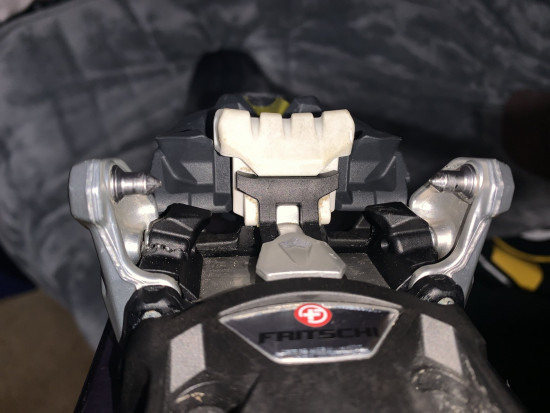Fritschi Tecton 13 Binding
Like the Ugly Duckling that grows to be a beautiful swan, the Fritschi Tecton has always stood out from other tech bindings. And like The Little Engine That Could, it exceeds all expectations of what traditional pin bindings are capable of. Thanks to the ingenious design of the toepiece, the lateral release occurs at the toe instead of the heel, which is designed to protect your anatomy in a similar manner as a typical alpine binding. Fritschi also engineered the toe to be impressively easy to step into with a simple pad that gets depressed by the toe of the boot, releasing the toe wings to snap into your inserts. The alpine-style heel offers a familiar and confidence-inspiring hold on the boot. Transitioning involves pushing the heel lever flat from a vertical position, with no twisting of heel pieces required. From a construction standpoint, the high-grade composite used in the binding not only keeps the weight low but also acts to dampen out vibrations from the ski, delivering an impressively smooth ride no matter the snow conditions. Whether you’re skiing in-bounds to Where the Sidewalk Ends or touring to Where the Wild Things Are, the Fritschi Tecton 13 will keep you asking for more, much like that little mouse you should have never given a cookie to.
- Fully adjustable forward and lateral release from 5-13 to tune retention for a wide range of skiers.
- High-grade carbon-infused plastics absorb shocks from the ski for a damp ride in any conditions.
- Lateral release at the toe, similar to alpine bindings, to align release torque with tibial axis.
- Revamped ultra-easy step-in means no frustrating fiddling to get into the binding.
- Elasticity in the toe (13mm) and heel (9mm) reduces the chances of pre-release.
- Three included colored inserts allow you to customize your binding to match your style.
Update 2024/25: The toes and heels are reinforced, but the binding remains functionally the same. For example, the toe levers have metal inserts to better withstand sharp pole tips.
| Specifications | |
|
Weight |
638g [100mm] |
| Weight (pair) | 1276g [100mm] |
|
Boot |
Tech |
|
Brakes |
90, 100, 110, 120 |
|
BSL |
25mm |
|
Riser |
2 + flat |
|
Vertical |
5-13 |
|
Lateral |
5-13 |
|
Crampon |
Yes |
| Specs Verified | Yes |
| Design | |
|
|
Steel, aluminum, plastic |
| Skimo Co Says | |
| Usage | In-bounds, out-of-bounds, all-the-bounds |
| Notes | Lateral release is controlled at the toe like an alpine binding |
| Bottom Line | An excellent binding for charging skiers seeking a smooth ride |
| Compare to other Full-featured Bindings | |
Related Products
Questions & Reviews
The hole pattern on these bindings has not changed since that time. You should be able to drop it right in.
We've got a chart here with all the numbers!
Yes, it will! The Tecton 13 has a tech toe piece, so it just needs tech inserts at the toe and a large enough heel welt for the alpine-style heel piece to clamp onto. Should be no issue with that boot.
Fritschi claims 26mm of total lateral elastic travel in the toepiece of the Tecton 13 on their website, or 13mm in either direction. We also list this in our product description.
From this photo, I cannot say if they are OK to use.
Skis a tiny bit smoother since there is some elasticity in the toe. Neglibile differences at moderate speeds in good snow vs a lightweight tech binding.
Lateral toe release makes these (and the Vipec) a bit safer.
Lots of moving parts. The heel snaps down scary hard to the point Im surprised I haven't lost a finger.
Both very similar bindings! The Vipec has heel pins whereas the Tecton has an alpine style heel. The alpine style heel gives you better vertical elasticity, but weighs about 100 grams more. Other than that, the toes are very similar, the mechanism to change from ski to walk is very similar, risers are similar heights, etc.
In all seriousness, it was a change in the materials and spring strength to allow it to perform at a slightly higher level. I would say it's 8.3% improved :)
The plastic dampens some vibrations, and the freeride spacer keeps you anchored when landing big jumps. Unfortunately, we don't really have any sort of scale for downhill performance, so it's difficult to gauge how noticeable these benefits will be.
If you want some help deciding, feel free to fill out a binding finder!
The stack height is pretty negligible - a higher stack height could give you more leverage over the ski, while a lower one could make you feel more stable, but it wouldn’t be very noticeable.
The delta on the other hand would be noticeable- delta is the difference in height between the toe and heel. The Zed is pretty neutral. The Tecton, ATK Crest, and Raider for example are more pitched forward, so people often shim the toes to create a more neutral delta angle.
Earn store credit by writing reviews. Learn more.






